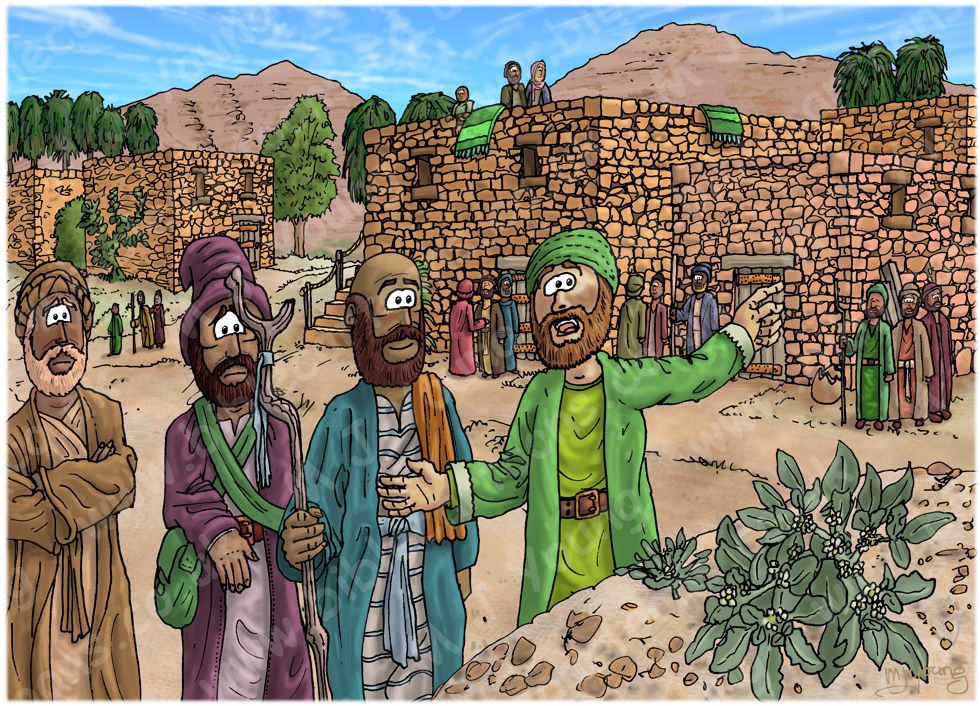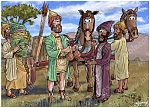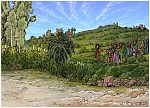Bible Cartoon: 2 Kings 06 - Axe-head floats - Scene 01 - Meeting place too small
Click on Add to cart button below shopping cart.
Purchased Bible Cartoons do not have watermarks. Links to Cartoons provided on email once purchase is completed.Bible Book: 2 Kings
Bible Book Code: 1200600101
Scene no: 1 of 4
Bible Reference & Cartoon Description
2 Kings 6:1-3 (ANIV)
1 The company of the prophets said to Elisha, “Look, the place where we meet with you is too small for us. 2 Let us go to the Jordan, where each of us can get a pole; and let us build a place there for us to live.”
And he said, “Go.”
3 Then one of them said, “Won’t you please come with your servants?”
“I will,” Elisha replied.
DRAWING NOTES:
TIME OF DAY:
Unspecified in Bible verses above. I have set this scene in the mid morning.
LIGHTING NOTES:
The sun (unseen, above & right) illuminates this scene, casting shadows to the left of figures & objects.
CHARACTERS PRESENT:
From left to right: One of the prophets (from the company of the prophets), Gehazi (in purple robes & hat, one of Elisha’s servants), Elisha, the man of God (in blue outer robes, striped inner robe & carrying Elijah’s mantle on his shoulder). Another of the prophets is pointing back towards a small stone house, which is the meeting place of the company of the prophets in question.
The other men near the small stone house are all members of the company of the prophets.
In the background are people from the town/city of Jericho.
RESEARCH/ADDITIONAL NOTES:
This scene shows Elisha talking to members of the company of prophets [1], regarding the size of their meeting place. Apparently, Elisha’s many miracles had caused an increase in the number of people wanting to join the company. This is in strong contrast to the other people of Israel, who were generally going over to the idolatry of Baal worship, instead of the proper worship of the Lord God.
Here is the scene without the figures in the foreground.

Background of 2 Kings 06 – Axe-head floats – Scene 01 – Meeting place too small
Click on the colour bar below to view/buy this Background:
Background of 2 Kings 06 – Axe-head floats – Scene 01 – Meeting place too small
There is a strange phrase in verse 2, “…each of us can get a pole.” It is supposed that the company of prophets were proposing to go to the Jordan river, and to cut down trees, to make logs/beams, which could then be used to make a large wooden hut or house, in which they could all meet comfortably. Other Bible translations confirm this interpretation of “pole”, by referring to “logs”, “beams”, etc. 2 Kings 6:2 (The Message Version) gives us a clearer translation: “2 Give us permission to go down to the Jordan where each of us will get a log. We’ll build a roomier place.”
Notice that Gehazi has a white tinge to his skin, which is the leprosy he was infected with, when he tried to lie & hide silver & clothing given to him through deception from Naaman, the Aramean army commandeer (see 2 Kings chp 5).
I have used the same colour for the stone buildings as the upper walls of the city of Jericho from Joshua 06 – Fall of Jericho – Scene 03 – Circling Jericho.
The small green plant on the foreground sandy outcrop (and beneath the feet of the foreground figures) is Anastatica hierochuntica (aka the Rose of Jericho, Resurrection plant). This remarkable plant can survive for a very long time in a completely desiccated (apparently dead) state. The true rose of Jericho (Anastatica hierochuntica) is native to western Asia and is the only species of the genus Anastatica of the mustard family (Brassicaceae). The small gray plant curls its branches and seedpods inward in the dry season, forming a ball that opens only when moistened. It can survive for years in that form, though it is sometimes uprooted and blown by the wind like a tumbleweed. If still rooted when moistened, it spreads into a green plant up to 1 foot (30 cm) wide and bears minute white flowers, with yellow centres.
[1]
The Blue Letter Bible translates the term into “The sons of the prophets”.
What was the company of the propehts?
There appear to have been several groups of men who could broadly be referred to as the company of the prophets. The “Got Questions” website has a good article about these men (see below). It seems that a prophet such as Elijah or Elisha attracted a group of youths to themselves who wished to learn from them & perhaps receive a measure of the prophets divinely inspired abilities. I imagine that the particular group mentioned in 2 Kings chp 6 above were either those based in Bethel, or else in Jericho (which are mentioned in the Bible (see 2 Kings 2), although they could have been based in Samaria.
“The Old Testament mentions a school of prophets in 1 Samuel 19:18–24 and in 2 Kings 2 and 4:38–44 (some translations say “company of prophets” or “sons of the prophets”). Also, the prophet Amos possibly mentions a prophetic school in stating his credentials (or lack thereof) to Amaziah the priest: “I was neither a prophet nor the son of a prophet” (Amos 7:14).
First Samuel 19 relates an account in which King Saul sends messengers to arrest David. When these men encountered a company of prophets under Samuel’s leadership, the king’s men also prophesied. This happened three times. Saul himself then went, and he, too, prophesied, leading people to ask, “Is Saul also among the prophets?” (1 Samuel 19:24), which became a saying in those days.
The “group of prophets” in 1 Samuel 19 was clearly comprised of students of the prophet Samuel. These students were likely Levites who served in roles related to the tabernacle and ceremonial worship. The content of their “prophesies” is not specified. Their messages could have been general teachings from God’s laws in the Books of Moses, or they could have included additional revelation.
In 2 Kings 2 Elijah is traveling with Elisha, and a group of prophets from Bethel tells Elisha that Elijah would be taken from him that day (verse 3). Another group of prophets at Jericho repeats the prophecy (verse 5), and a third group of prophets near the Jordan River also delivers the same message (verse 7). This third group of 50 men may have been a subset of the group of prophets at Jericho. After Elijah was taken up into heaven, Elisha reluctantly sends 50 of these prophets to search for Elijah for three days (verses 15–18).
In 2 Kings 4:38–41 Elisha is in Gilgal during a time of famine. Elisha miraculously changes an inedible stew into a comestible dish for the group of prophets there. Chapter 4 ends with Elisha’s turning 20 loaves of bread into more than enough food for 100 people. Nothing else is mentioned about this school of prophets, though it is clear they lived together in some kind of community and were known as sons of the prophets who worshiped the Lord.
These groups of men were likely leaders among those 7,000 Israelites who had not bowed down to Baal, as God had told Elijah (1 Kings 19:18). There were at least three schools or communities of these prophets and possibly more, consisting of men who were devoted to God and served Him. They followed the teachings of Samuel, Elijah, and Elisha during the time of the prophets and were known as their “students.” “
[Source: https://www.gotquestions.org/school-of-prophets.html]





